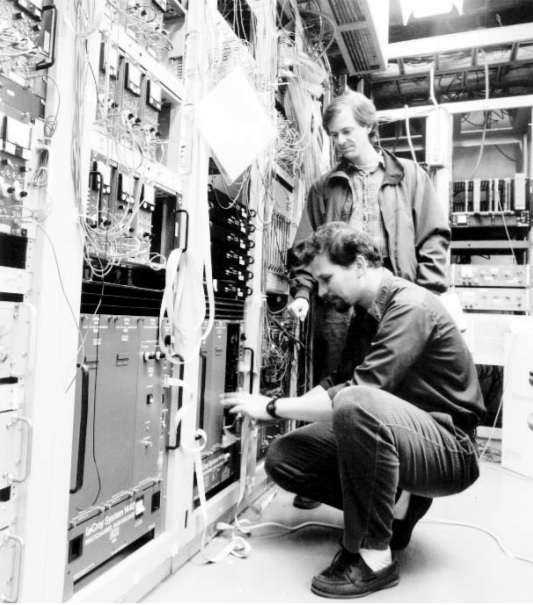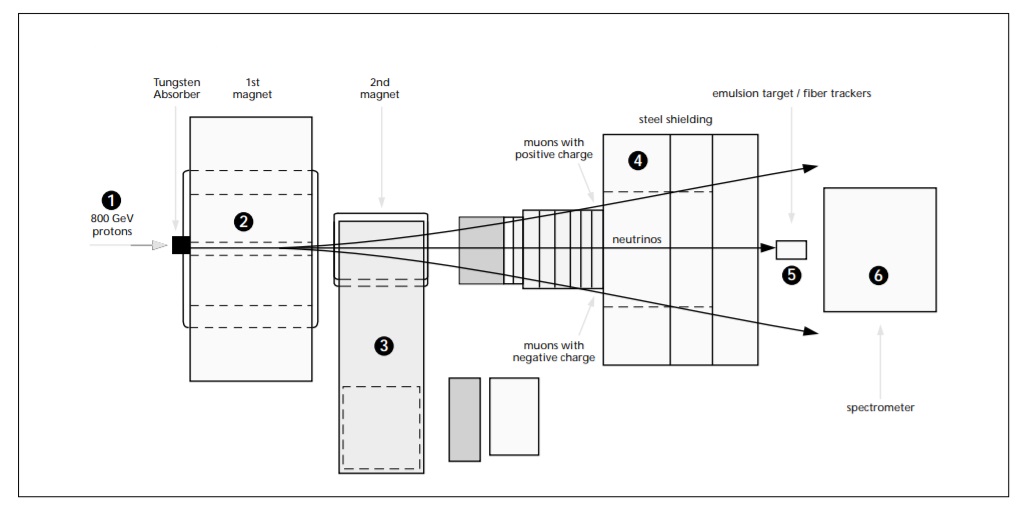Searching for the Standard Model Holdout
An international collaboration at Fermilab sets out to observe the elusive tau neutrino.
When two collaborations announced the discovery of the top quark at Fermi National Accelerator Laboratory in 1995, many news outlets erroneously reported that the last remaining piece of the current theory of matter and energy, known as the Standard Model, had been found. What reporters and even a few physicists forgot is that the elusive tau neutrino, while firmly entrenched in the Standard Model, has never been directly observed.
In the early 1980s, there was one minor attempt to find the tau neutrino at CERN, the European Laboratory for Particle Physics, and a few proposals emerged at Fermilab. Unfortunately, the CERN study yielded no data, and Fermilab abandoned its proposals due to cost and other priorities. However, a decade later a small band of scientists from four countries came together and proposed E872, the search for the tau neutrino. The experiment, a part of Fermilab’s current fixed–target run, began taking data on April 14 and offers scientists the best chance yet to observe the Standard Model’s stubborn holdout.
Gina Rameika, an E872 collaborator, admitted that some particle physicists have said it is not critically important to find the tau neutrino, since they are sure it is right where the Standard Model says it is. However, Vittorio Paolone, cospokesman for E872, said two factors persuaded researchers to go after the tau neutrino. The first, quite simply, is to find the mysterious particle and understand its properties. Moreover, the experiment is a precursor to the Neutrinos at the Main Injector (NuMI) project, the search for neutrino mass. Paolone says it is vital that researchers first directly observe the tau neutrino before they embark on the quest to see if it and the other two neutrinos, the muon and electron neutrino, have mass.
"We felt one should directly observe it, because there could be surprises," said Ken Heller, a scientist from the University of Minnesota working on E872. "History tells us not to take anything for granted."
Neutrino History
Of all nature’s building blocks, the subatomic particles known as neutrinos are the most elusive. Neutrinos are hard particles to pin down because they have no electric charge and very little, if any, mass. Wolfgang Pauli first postulated their existence in 1930, and more than 20 years later Frederick Reines and Clyde Cowan reported the first evidence for the particles. In 1962, a group of scientists from Columbia University and Brookhaven National Laboratory performed the first accelerator neutrino experiment and demonstrated the existence of two “flavors” of neutrinos, the electron neutrino and the muon neutrino. [In 1988, Jack Steinberger, Mel Schwartz and Leon Lederman, Fermilab director emeritus, won the Nobel Prize for the discovery.] In 1975, a group of scientists at the Stanford Linear Accelerator, led by Martin Perl, discovered the tau lepton, and subsequent experiments provided strong evidence that there also exists a third species of neutrino, the tau neutrino.
In the 1980s, shortly after the CERN attempt to see the tau neutrino, Fermilab researchers proposed an entire new complex—the Direct Neutral Heavy Lepton Facility—to find the particle. They eventually abandoned the idea. For nearly a decade researchers discussed other ideas for finding the particle, but no solid proposal, or interest, emerged. Then, in 1993 at the home of Fermilab physicists Byron Lundberg and Rameika, a casual dinner conversation begot the current Fermilab experiment.
Rameika was telling Lundberg about the NuMI project, explaining how excited she was at the chance to research neutrino mass—a phenomenon that could help explain a large part of the universe’s mass, 90 percent of which is currently unknown.
“And Byron said, ‘You’re right; it’s one of the best new topics out there. However, it would sure be nice if someone had seen a tau neutrino,’” Rameika said, recounting the conversation.
Rameika agreed, saying it would be important for researchers first to observe the tau neutrino and its properties so if the particle does strike NuMI’s detector, scientists will know what it looks like.
Rameika queried her husband about how one would go about conducting a tau neutrino search, and the next night Lundberg brought home an old memo from Experiment 653, which Lundberg had worked on in the mid ’80s with a team from Nagoya University in Japan. E653 searched for b particles using emulsion for high–precision tracking. At one point, the collaboration proposed using a similar technique for finding tau neutrinos, but “no one picked up on it, and it fell by the wayside,” said Rameika.
Two days after the dinner conversation, Lundberg calculated a way to observe about 100 tau neutrinos in an experiment. Lundberg and Rameika shared the idea for a tau neutrino search with other scientists, including Niwa Kimio from Nagoya University. Over the course of 1993 and early 1994, a collaboration formed and proposed an experiment for the fixed–target run scheduled to begin in 1996—a late addition to the series of experiments already approved.
Building the Beamline
The late proposal and approval of E872 put the study behind the other fixed–target experiments; mechanical and technical support didn’t arrive until the others had completed their beamline and detector construction. Along with the late setup, the E872 team had the additional challenge of building a complex, nontraditional beamline configuration.
Due to their properties, neutrinos zip through all material with very few interactions to speak of. To see even a scarce few of these interactions, experimenters need a tremendous number of protons to produce an equally tremendous number of neutrinos. Just how many? When complete, the experiment will have produced 100 trillion neutrinos, 95 percent of which will be muon or electron neutrinos. Of the remaining five percent of tau neutrinos, the detector will record fewer than 100 events.
“You have to produce [tau neutrinos] by brute force,” said Lundberg, cospokesman for E872.
The protons, accelerated to 800 GeV by Fermilab’s Tevatron, speed down the beampipe, crashing into a tungsten beam absorber. The interactions of the protons with the tungsten produce many unneeded particles, most of which are quickly absorbed. However, protons interacting with the tungsten also create all three flavors of neutrinos as well as muon particles, which the absorber can’t stop, allowing them all to hurtle toward the detector. Muons, which can have a positive or negative charge, would flood the detector and, in essence, make it blind to neutrino interactions. Thus, the primary design feature of the beamline involves keeping the muons out of the detector, while capturing as many neutrinos as possible (see diagram above).
Another factor for the beam designers was keeping the proton beam as “clean” as possible, as the protons speed down the pipe. Any interaction of protons with devices in the pipe can also produce the dreaded muons. To prevent this, the experimenters designed an unusual beamline that runs without any beam monitors—common devices used in most other high–energy physics experiments to position the particle beam in the beamline. The E872 team must first run the proton beam at low intensity while using monitors, tune it to their required parameters, remove the monitors and crank up the intensity—flying blind, in essence.
The second unusual beamline design feature is the proximity of the detector to the beam dump. The emulsion detector is only 36 meters away from the tungsten dump, considerably closer than in all other fixed–target experiments. Why so close? Neutrinos tend to spread out as they move forward—like the light from a flashlight—so a detector must be as close as possible to capture them. However, the detector must still be far enough away to let muons pass to either side and not flood the sensitive emulsion. Because muons have a charge, a magnetic field can steer them away, while the chargeless neutrinos remain unaffected by the field and continue straight ahead into the detector.
Due to the special beamline design considerations, the researchers needed about four months to debug the beamline. Lundberg said when experimenters first tested the line, they had 20 times more muons in the detector than they wanted; they have since knocked that number down to acceptable levels. The result of the laborious design specifications gives the collaboration the best chance to see tau neutrinos.
Detector Overlap
The experiment’s detector layout consists of three components: an emulsion target, conventional spectrometer and scintillating fiber trackers. Emulsion, an older particle detection technique that is like photographic film, is the critical part of the detector; particles traverse the emulsion and leave tracks as they go through. Interwoven with the emulsion are scintillating fiber trackers that use light to capture information about the particle, such as its momentum and position. The last stage of the detection components is the array of drift chambers, which are common to most high–energy physics experiments.
While many fixed–target experiments can process and analyze data as it is collected, the tau neutrino scientists have to wait for awhile to see if they have success. The researchers must complete the full run before removing the emulsion modules. While scientists in the United States will analyze most of the data in the standard electronic detectors, Japanese collaborators will take the emulsion back to Japan for development, processing and analysis of its contents. Only by analyzing and comparing the information in all of the detectors will the scientists know if they have the tau neutrino in their grasp.
Rameika said she expects the collaboration will see the stubborn particle. Since they started later than expected, researchers will receive fewer protons than they had planned. Originally Lundberg and Paolone hoped to see 200 tau neutrinos; now they expect to see about 90. However, with data streaming into their detectors and the muon rates staying low, collaborators are getting eager.
“I think there is little doubt that we will see it; the question is how many of them are there? There is some excitement brewing here,” said Lundberg. “We should see the first one in about 18 months or so.”






